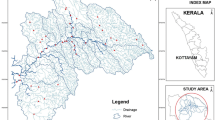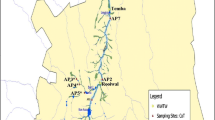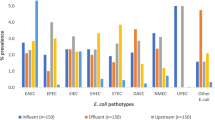Abstract
The discharge of untreated or inadequately treated effluents has been identified among the activities responsible for the spread of a wide range of potentially infectious agents. The aim of this study was to determine whether inadequate treatment of wastewater and the faecal pollution load of effluents and receiving water bodies in Sedibeng District and Soshanguve peri-urban area of the Tshwane Metropolitan Municipality could be a potential threat to the health of the surrounding communities. Variations in the counts of faecal indicator bacteria and pathogenic microorganisms and compliance of the effluents and receiving water bodies with South African and World Health Organization standards were assessed between August 2011 and May 2012 using culture-based methods and molecular techniques. The overall quality of effluents did not comply with the South African special standard of no risk for unrestricted irrigation (zero Escherichia coli/100 ml). The quality of the receiving water bodies did not comply with South African regulatory limits set for domestic purposes (zero E. coli/100 ml, <30 faecal enterococci/100 ml and <1 somatic coliphages/100 ml), for full contact recreation (<20 somatic coliphages/100 ml) and aquaculture (<10 E. coli/100 ml) and WHO standards for full and intermediate contact recreational use (<1 E. coli/100 ml and <40 faecal enterococci/100 ml, respectively). The PCR results revealed the prevalence of pathogenic microorganisms; between 0 and 60 % of samples tested positive for Salmonella Typhimurium and Shigella dysenteriae, and between 20 and 60 % of samples tested positive for Vibrio cholerae. These findings demonstrated that potential health risks might be associated with the use of the target river waters for domestic, recreational and irrigation purposes. This study calls for a prompt intervention to improve wastewater management.

Similar content being viewed by others
References
Adewumi JR, Ilemobade AA, Van Zyl JE (2010) Treated wastewater reuse in South Africa: Overview, potential and challenges. Resour Conserv Recycl 55:221–231
APHA (2001) Revisions to standard methods for the examination of water and wastewater (supplement). American Public Health Association, Washington DC, USA
Bisson JW, Cabelli VJ (1979) Membrane filter enumeration method for Clostridium perfringens. Appl Environ Microbiol 37(1):55–66
Bisson JW, Cabelli VJ (1980) Clostridium perfringens as a water pollution indicator. J Water Pollut Control Fed 52(2):241–248
Brözel VS, Cloete TE (1991) Fingerprinting of commercially available water treatment bactericides in South Africa. Water SA 17(1):57–66
Burkhardt W III, Calci KR, Watkins WD, Rippey SR, Chirtel SJ (2000) Inactivation of indicator microorganisms in estuarine waters. Water Res 34:2207–2214
Castillo MM, Allan JD, Sinsabaugh RL, Kling GW (2004) Seasonal and inter-annual variation of bacterial production in lowland rivers of the Orinoco basin. Freshw Biol 49:1400–1414
Cimenti M, Hubberstey A, Bewtra JK, Biswas N (2007) Alternative methods in tracking sources of microbial contamination in waters. Water SA 33:183–193
Das A, Mazumder Y, Dutta BR, Shome BR, Bujarbaruah KM, Kumar R (2012) Molecular typing of Clostridium perfringens isolated from diarrhoeic cattle. J Anim Sci Adv 2(2):226–229
Department of Health (2006) Mortality and morbidity among women and children. Annual Report, Government Printer, Pretoria South Africa
Dickens CWS, Graham PM (1998) Biomonitoring for effective management of wastewater discharges and the health of the river environment. Aquat Ecosyst Health Manag 1:199–217
DWA (2011) South African Waste Water Quality Management Performance. Green Drop Report. Green Drop Certification. Department of Water Affairs and Forestry, Pretoria, South Africa
DWA (2012) South African Waste Water Quality Management Performance. Green Drop Report. Green Drop Certification. Department of Water Affairs and Forestry, Pretoria, South Africa
DWAF (1996a) South African Water Quality Guidelines (2nd edn.) Vol. 2: Domestic Use. Department of Water Affairs and Forestry, Pretoria, South Africa, pp 86–87
DWAF (1996b) Community water supply and sanitation: Strategic Study-National Assessment. Department of Water Affairs and Forestry. South Africa, Pretoria
DWAF (2004) Revision of General Authorizations in terms of Section 39 of the National Water Act, 1998 (Act No. 36 of 1998). South African Government Gazette No. 26187. Department of Water Affairs and Forestry, Pretoria, South Africa
DWAF (2009) Water Resources Planning Systems. Orange River: assessment of water quality data requirements for water quality planning purposes. Report No.5. PRSA D000/00/8009/2. Department of Water Affairs and Forestry, Pretoria, South Africa
Edberg SC, Rice EW, Karlin RJ, Allen MJ (2000) Escherichia coli: the best biological drinking water indicator for public health protection. J Appl Microbiol 88:106–116
Enriquez C, Nwachuku N, Gerba CP (2001) Direct exposure to animal enteric pathogens. Rev Environ Health 16(2):117–131
Espinosa AC, Arias CF, Sánchez-Colón S, Mazari-Hiriart M (2009) Comparative study of enteric viruses, coliphages and indicator bacteria for evaluating water quality in a tropical high-altitude system. Environ Health 8:49
Field KG, Samadpour M (2007) Faecal sources tracking, the indicator paradigm and managing water quality. Water Res 41(16):3517–3538
Gerba CP, Rose JB (1990) Viruses in sources and drinking water. In: McFeters GA (ed) Drinking Water Microbiology. Springer-Verlag, New York, pp 380–396
Gleeson C, Gray N (1997) The coliform index and waterborne diseases: Problems of microbial drinking water assessment. E & F.N. Spon Ltd., London, UK
Goel AK, Ponmariappan S, Kamboj DV and Singh L (2007) Single multiplex polymerase chain reaction for environmental surveillance for toxigenic-pathogenic O1 and non-O1 Vibrio cholerae. Folia Microbiological 52(1):81–85
Grabow WOK (2001) Bacteriophages: Update on application as models for viruses in water. Water SA 27:251–268
Haigh EH, Fox HE, Davies-Coleman HD (2010) Framework for local governments to implement integrated water resources management linked to water services delivery. Water SA 36(4):475–486
Igbinosa EO, Okoh AI (2009) Impact of discharge wastewater effluents on the physicochemical qualities of a receiving water shed in a typical rural community. Int J Environ Sci Technol 6:175–182
ISO (2000) Water quality—detection and enumeration of bacteriophages: enumeration of somatic coliphages. International Standards Organization, ISO 10705, Part 2
Jessup D (2001) Marine mammals face increased mortality rate. The Environmental and Energy Study Institute, Washington DC
Jofre J, Olle E, Ribas F, Vidal A, Lucena F (1995) Potential usefulness of bacteriophages that infect Bacteriodes fragilis as model organisms for monitoring virus removal in drinking water treatment plants. Appl Environ Microbiol 61(9):3227–3231
Ke D, Picard FJ, Martineau F, Menard C, Roy PH, Ouellette M, Bergeron MG (1999) Development of a PCR assay for rapid detection of enterococci. J Clin Microbiol 37:3497–3503
Kong RYC, Lee SKY, Law TWF, Law SHW, Wu RSS (2002) Rapid detection of six types of bacterial pathogens in marine waters by multiplex PCR. Water Res 36:2802–2812
Lederberg J (1999) Encyclopedia of microbiology. Academic Press, San Diego CA, p 2000
Maddocks S, Olma T, Chen S (2002) Comparison of CHROMagar Salmonella medium and Xylose-Lysine-Desoxycholate and Salmonella-Shigella agars for isolation of Salmonella strains from stool samples. J Clin Microbiol 40(8):2999–3003
Maimon A, Tal A, Friedler E, Gross A (2010) Safe on-site reuse of greywater for irrigation—a critical review of current guidelines. Environ Sci Technol 44:3213–3220
Mara D (1976) Sewage treatment in hot climates. John Wiley, New York, USA
McFeters GA, Bissonnette GK, Jezeski JJ (1974) Comparative survival of indicator bacteria and enteric pathogens in well water. Appl Environ Microbiol 27:823–829
McQuaig SM, Scott TM, Harwood VJ, Farrah SR, Lukasik JO (2006) Detection of human derived faecal pollution in environmental waters by use of a PCR-based human polyomavirus assay. Appl Environ Microbiol 72(12):7567–7574
Merck Catalogue Number 1.07667.0500. (2014) Salmonella-Shigella Agar. Salmonella and Shigella diagnostic Agar. Merck KGaA, Darmstadt, Germany
Merck Catalogue Number 1.10263.0500. (2014) Thiosulfate Citrate Bile Salt Agar. Vibrio diagnostic Agar. Merck KGaA, Darmstadt, Germany
Metcalf and Eddy (2004). Wastewater engineering: treatment and reuse (4th ed.). Revised by: Techobanoglous, G., Burton, FL. & Stensel, HD. McGraw-Hill, New York
Mocé-Llivina L, Muniesa M, Pimenta-Vale H, Lucena F, Jofre J (2003) Survival of bacterial indicator species and bacteriophages after thermal treatment of sludge and sewage. Appl Environ Microbiol 69(3):1452–1456
Momba MNB and Mfenyana C (2005) Inadequate treatment of wastewater: a source of coliform bacteria in receiving surface water bodies in developing countries—case study: Eastern Cape Province of South Africa. In: Lehr JH and Keeley J (eds.) Water Encyclopaedia - Domestic, Municipal and Industrial Water Supply and Waste Disposal. John Wiley & Sons. pp. 661-667
Momba MNB, Osode AN, Sibewu M (2006) The impact of inadequate wastewater treatment on the receiving water bodies-case study: Buffalo City and Nkonkobe Municipalities of the Eastern Cape. Water SA 32(5):687–692
Nandi B, Nandy RK, Mukhopadhyay S, Nair GB, Shimada T, Ghose AC (2000) Rapid method for species-specific identification of Vibrio using primers targeted to the gene of outer membrane protein OmpW. J Clin Microbiol 38(11):4145–4151
Noble RT, Blackwood AD, Griffith JF, McGee CD, Weisberg SB (2010) Comparison of rapid quantitative PCR-based and conventional culture-based methods for enumeration of Enterococcus spp. and Escherichia coli in recreational waters. Appl Environ Microbiol 76(22):7437–7443
Payment P, Franco E (1993) Clostridium perfringens and somatic coliphages as indicators of the efficiency of drinking water treatment for viruses and protozoan cysts. Appl Environ Microbiol 59(8):2418–2424
Peter D, Andrew AC, Alex DH (2000) Emerging infectious diseases of wildlife: threat to biodiversity and human health. Sci 287:443–445
Postel SL, Daily GC, Ehrlich PR (1996) Human appropriation of renewable fresh water. Sci 271(5250):785–788
SABS (2003) Water quality—detection and enumeration of Vibrio cholerae. South African National Standards (edn. 1). SANS Method 6315. South African Bureau of Standards, Pretoria, South Africa, pp 1–14
Samie A, Obi CL, Igumbor JO, Momba MNB (2009) Focus on 14 sewage treatment plants in the Mpumalanga Province, South Africa in order to gauge the efficiency of wastewater treatment. Afr J Biotechnol 8(14):3276–3285
Savichtcheva O, Okabe S (2006) Alternative indicators of faecal pollution: Relations with pathogens and conventional indicators, current methodologies for direct pathogen monitoring and future application perspectives. Water Res 40:2463–2476
Simpson JM, Santo Domingo JW, Reasoner DJ (2002) Microbial source tracking: state of the science. Environ Sci Technol 36(24):5279–5288
Slots J (1986) Bacterial specificity in adult periodontitis. A summary of recent work. I. Clin Periodontol 13:912–917
Snyman HG, Van Niekerk AM and Rajasakran N (2006) Sustainable wastewater treatment—What has gone wrong and how do we get back on track. Proceedings of the Water Institute of South Africa (WISA) Conference, Durban, 21-25 May 2006
StataCorp (2009) Stata time-series reference manual. Release 11, Statistical Software, College station, TX: StataCorp LP, Texas, USA
Stoeckel DM, Harwood VJ (2007) Performance, design and analysis in microbial sources tracking studies. Appl Environ Microbiol 73(8):2405–2415
Stroeher UH, Karageorgos LE, Morona R, Manning PA (1992) Serotype conversion in Vibrio cholerae 01. Proc Natl Acad Sci U S A 89(7):2566–2570
Sundram A, Donnelly L, Ehlers MM, Vrey A, Grabow WOK, Bailey IW (2002) Evaluation of FENA as indicators of viruses and sources of faecal pollution. Water SA. Special edition WISA proceedings. Available from: http://www.wrc.org.za/Knowledge%20Documents/Water%20SA%20Journals/Manuscripts/2002/05/WaterSA_2002_05_18.pdf. Accessed 07 March 2014
Thiem VD, Sethabutr O, Seidlein LV, Tung TV, Canh DG, Chien BT, Tho LH, Lee H, Houng HS, Hale TL, Clemens JD, Mason C, Trach DD (2004) Detection of Shigella by PCR assay targeting the ipaH gene suggests increased prevalence of Shigellosis in Nha Trang. Vietnam J Clin Microbiol 42:2031–2035
Tiefenthaler L, Stein ED, Schiff KC (2011) Levels and patterns of faecal indicator bacteria in stormwater runoff from homogenous land use sites and urban watersheds. J Water Health 9:279–290
Tsai YL, Palmer CJ, Sangermano LR (1993) Detection of Escherichia coli in sewage and sludge by polymerase chain reaction. Appl Environ Microbiol 59:353–357
UNESCO/WHO/UNEP (1996) Water quality assessment: a guide to use of biota, sediments and water environment (2nd edn.). Cambridge University Press, Cambridge
USEPA (2001) EPA Method 1602: male specific (F+) and somatic coliphages enumeration in water by single layer (SAL) procedure. EPA Report 821-R-01-029. US Environmental Protection Agency, Washington DC, USA
WHO (1996) Guidelines for drinking water quality (2nd edn.). Vol. 2. World Health Organization, Geneva, Switzerland
WHO (2001) Guidelines: the current position. In: Lorna F, Jamie B (eds) Water quality: Guidelines, Standards and Health. IWA Publishing, London, UK
WHO (2004) Guidelines for drinking-water quality (3rd edn.). Vol. 1: Recommendation. World Health Organization, Geneva, Switzerland, pp 259–274
WHO (2009a) Cholera annual report 2008. Wkly Epidemiol Rec 84(31):309–324
WHO (2009b) Global task force on cholera control. World Health Organization. Available from: www.who.int/cholera/countries/Zimbabwecountry profile2009.pdf. Accessed on 07 October 2012
Wilkes G, Edge T, Gannon V, Jokiene C, Lyautey E, Medeiros D, Neumann N, Ruecker N, Topp E, Lapen DR (2009) Seasonal relationships among indicator bacteria, pathogenic bacteria, Cryptosporidium oocysts, Giardia cysts and hydrogeological indices for surface waters within an agricultural landscape. Water Res 43(8):2209–2223
Wohlsen T, Bayliss J, Gray B, Bates J, Katouli M (2006) Evaluation of an alternative method for the enumeration and confirmation of Clostridium perfringens from treated and untreated sewage. Lett Appl Microbiol 42:438–444
Acknowledgments
The authors would like to thank the National Research Foundation (NRF) and the Tshwane University of Technology for the funding of this project.
Author information
Authors and Affiliations
Corresponding author
Additional information
Responsible editor: Philippe Garrigues
Rights and permissions
About this article
Cite this article
Teklehaimanot, G.Z., Coetzee, M.A.A. & Momba, M.N.B. Faecal pollution loads in the wastewater effluents and receiving water bodies: a potential threat to the health of Sedibeng and Soshanguve communities, South Africa. Environ Sci Pollut Res 21, 9589–9603 (2014). https://doi.org/10.1007/s11356-014-2980-y
Received:
Accepted:
Published:
Issue Date:
DOI: https://doi.org/10.1007/s11356-014-2980-y




